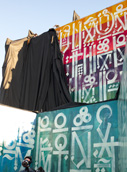Editor’s Note: This is the third installment of Santa Monica Pier Aquarium Director Vicki Wawerchak’s account of preparing harbor seal and sea lion skulls to become artifacts on display at the Aquarium. (Read Parts One and Two)
Saltwater maceration takes time—and as someone who likes instant gratification, this was going to be a long process. But patience, I’m told, is a virtue. The saltwater soaking marked the final step in cleaning our newly donated harbor seal and seal lion skulls and prepping them for exhibition. Aquarium staff will use them to educate the general public and students about the various marine mammals that call the Santa Monica Bay home.
Large buckets and lids were purchased at Home Depot, holes drilled into the sides of them and ropes affixed to each one. We labeled the vessels with the skull type, date and Aquarium contact information. We removed the skulls from the freezer, carefully unwrapped them and placed them in buckets to be hung off the side of a dock to let nature do its job.
The idea behind saltwater maceration is to let bacteria and various animals decompose flesh by breaking down the proteins in the cells. By placing the skulls in the buckets and lowering them in saltwater, we let the natural ocean environment and its inhabitants do the dirty work for us. All we would have to do was to check them every month or so and wait…and wait…and wait.
“Don’t forget to check the skulls today!” I would text Jose and Seth (Aquarium aquarists) when they were on a collection snorkel—so different from the usual ones sent to remind each other of meetings, deadlines or to pick up supplies on the way in. But every few weeks I couldn’t stand it. I would request photos of the skulls mid process so I could watch the decomposition take place. And Jose and Seth obliged, taking the time to haul up the buckets, let the water drain out, open the lid, ignore the putrid odor, and take a few photos. I would sit by my phone anticipating the “ding” to let me know a photo of decomposing marine mammal skulls was waiting for me to view it. Each week a few more animals would adhere to the exterior of the buckets (mostly tunicates and tube worms) and inside the skulls lost more and more of their flesh.
Fast-forward about six months. After sending yet another nagging text to the aquarists I received one back stating, “I think they are done and we can’t wait for you to see them.” The long wait paid off. Tthe skulls were perfect. They were picked cleaned (for the most part) and only needed some spot flesh removal, a bit of scrubbing and time to allow them to dry out. Some of the teeth had fallen out and the flesh that held bone together had decomposed so some of the bones were no longer connected. But the difficult part was completed and after the cleaning and drying stage, the skulls were put back together. Teeth were glued into place and wire was used to articulate the skeleton. At the end of this long process, the Aquarium staff now has an amazing educational tool we can share with the Aquarium visitors.
And how happy was I to receive this email from our friends at The Marine Mammal Care Center in Sausalito, “I was cleaning out our necropsy freezer and found an adult male long beaked common dolphin skull!” We are now preparing for round two.
Speaking of skulls, please visit the Aquarium during the weekend of Oct. 22– 23 to see these artifacts as they will be on display as part of our “A Fishy Fest Celebrating Halloween and Dia de los Muertos.”



